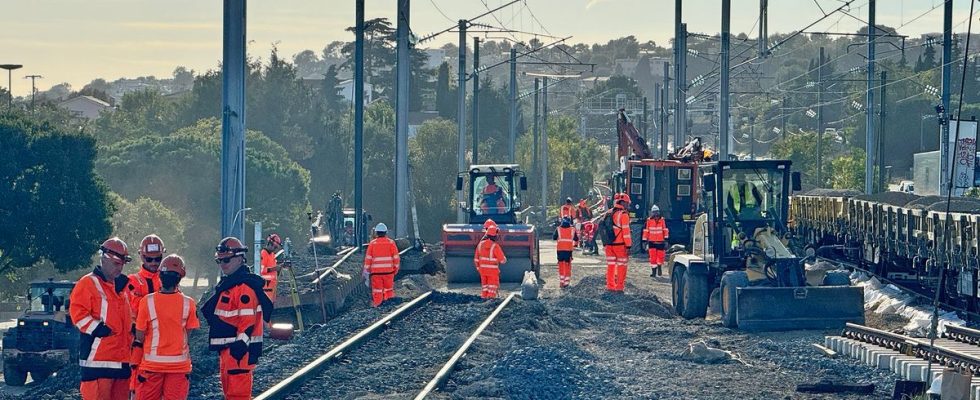A change to the signaling system to be able to increase the pace. On the rails, between Marseille and Ventimiglia (Italy), where this major railway line on the Mediterranean axis is at saturation, between the freight trains and those which transport tourists and workers every day, the time has come for major works.
“Beyond being a technical project, it is above all a desire to improve performance on the rail corridor along the Mediterranean, which goes from Barcelona [Espagne] to Venise [nord-est de l’Italie] », Explains Jean-Pierre Serrus, vice-president in charge of transport in the Provence-Alpes-Côte d’Azur (Paca) region. The project will make it possible to modernize equipment installed around sixty years ago, in the 1960s, during the electrification of the line, and which had not benefited from improvements since.
A “punch” operation in Cagnes-sur-Mer
On the French side, the project began in the summer of 2022 and should allow the progressive implementation of the pan-European signaling system ERTMS (European rail traffic management system) by 2030 in Bouches-du-Rhône and from 2027 in the Alpes-Maritimes. In mid-November, traffic was interrupted for a whole weekend between Nice and Antibes to allow the installation of four new compatible switches in the town of Cagnes-sur-Mer. A “one-two punch” operation carried out in three shifts, day and night, over a total of 54 hours, with the replacement of 40 m of rails being necessary each time. It was about “creating new Ys, which allow you to go from one path to another, and to go through the middle one. This is very useful for streamlining traffic when we have, in a short period of time, the passage of omnibus trains with TGVs and Marseille-Nice which stop less often,” we explained on site.
All with this new “connected” device. Already installed on high-speed lines, this system places signaling inside the driver’s cabin and allows real-time management of the spacing between trains, explains Jacques Paulet, director of the modernization program of the Marseille-Ventimiglia axis with the French operator SNCF Réseau.
Currently, messages pass through light signals installed every 2 kilometers along the tracks, 2 km being the distance necessary for freight trains, the heaviest and least modern, to stop safely. But the mainline trains and regional express trains (TER) which crisscross this major route are more efficient and can stop safely within 700 m. With a real-time system, we will therefore be able to have more driving on the same lane. A control center under construction in Marseille will manage connections by radio signal.
As petitions from dissatisfied users multiply
In total, between this center, the equipment of the tracks and the trains, the entire project is estimated at 750 million euros, financed by the State, SNCF Réseau/SNCF, the European Union and the Paca region. On the other side of the border, Italy has launched a 3.2 billion euro program to equip nearly 5,000 km of ERTMS lines. The Genoa-Ventimiglia axis must take the plunge in 2028 according to RFI, the company responsible for the Italian rail network. Enough to relaunch the Nice-Genoa direct connection projects.
But the major challenge in the coming years will be to convince as many residents and visitors as possible to prefer the train to the car, by offering a more complete and regular service. For the moment, petitions from dissatisfied users are increasing, in particular on the Grasse/Cannes-Nice-Monaco-Ventimiglia portion, the busiest regional line in France after the five RER lines in the Ile-de-France region.
Trains that are too short and crowded during rush hours, serial delays due to maintenance defects… Even if traffic jams do not make the road attractive, the daily lives of rail users are complicated on the Côte d’Azur.
“From a train every quarter of an hour to a train every ten minutes”
To remedy this, the transition to ERTMS is moving forward with the new Provence-Alpes-Côte d’Azur line project (LNPCA), which provides for new trains, improvements to stations and tracks, up to the construction of a station at Nice airport and the construction of an underground station at Marseille-Saint-Charles by 2035. It will also ultimately support the Regional Express Services (SER, close to the RER) project connected to other means transport in the metropolitan areas of Marseille, Toulon and Nice.
“We aim to go from a train every quarter of an hour to a train every ten minutes, or even more. It is at this price that we can aim for a modal shift and a profound decarbonization of the mobility of our fellow citizens,” explains Jean-Pierre Serrus.
Previously, the opening to competition should make it possible to increase the number of TERs by 75% at the end of 2024, with more trains throughout the day. But during peak hours, traffic is already at maximum capacity: to put more trains in, we will have to wait for the new signaling.

